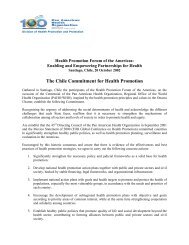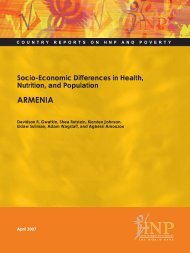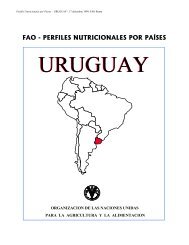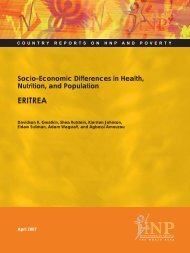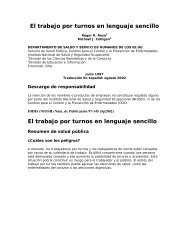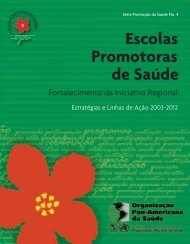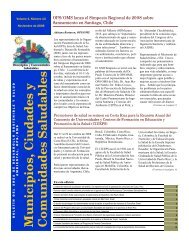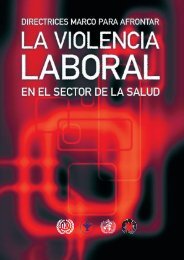Guidelines for drinking-water quality. Volume 1 - BVSDE
Guidelines for drinking-water quality. Volume 1 - BVSDE
Guidelines for drinking-water quality. Volume 1 - BVSDE
You also want an ePaper? Increase the reach of your titles
YUMPU automatically turns print PDFs into web optimized ePapers that Google loves.
term animal studies. Sometimes data are available on carcinogenicity in humans, mostly from<br />
occupational exposure.<br />
On the basis of the available evidence, IARC categorizes chemical substances with respect to<br />
their potential carcinogenic risk into the following groups (<strong>for</strong> a detailed description of the<br />
classifications, see box below):<br />
Evaluation of carcinogenic risk to humans<br />
IARC considers the body of evidence as a whole in order to reach an overall evaluation of the<br />
carcinogenicity <strong>for</strong> humans of an agent, mixture, or circumstance of exposure.<br />
The agent, mixture, or exposure circumstance is described according to the wording of one of the<br />
following categories, and the designated group is given. The categorization of an agent, mixture,<br />
or exposure circumstance is a matter of scientific judgement, reflecting the strength of the<br />
evidence derived from studies in humans and in experimental animals and from other relevant<br />
data.<br />
Group 1. The agent (mixture) is carcinogenic to humans.<br />
The exposure circumstance entails exposures that are carcinogenic to humans.<br />
This category is used when there is sufficient evidence of carcinogenicity in humans.<br />
Exceptionally, an agent (mixture) may be placed in this category when evidence in humans is<br />
less than sufficient but there is sufficient evidence of carcinogenicity in experimental animals and<br />
strong evidence in exposed humans that the agent (mixture) acts through a relevant mechanism<br />
of carcinogenicity.<br />
Group 2<br />
This category includes agents, mixtures, and exposure circumstances <strong>for</strong> which, at one extreme,<br />
the degree of evidence of carcinogenicity in humans is almost sufficient, as well as those <strong>for</strong><br />
which, at the other extreme, there are no human data but <strong>for</strong> which there is evidence of<br />
carcinogenicity in experimental animals. Agents, mixtures, and exposure circumstances are<br />
assigned to either group 2A (probably carcinogenic to humans) or group 2B (possibly<br />
carcinogenic to humans) on the basis of epidemiological and experimental evidence of<br />
carcinogenicity and other relevant data.<br />
Group 2A. The agent (mixture) is probably carcinogenic to humans.<br />
The exposure circumstance entails exposures that are probably carcinogenic to humans.<br />
This category is used when there is limited evidence of carcinogenicity in humans and sufficient<br />
evidence of carcinogenicity in experimental animals. In some cases, an agent (mixture) may be<br />
classified in this category when there is inadequate evidence of carcinogenicity in humans and<br />
sufficient evidence of carcinogenicity in experimental animals and strong evidence that the<br />
carcinogenesis is mediated by a mechanism that also operates in humans. Exceptionally, an<br />
agent, mixture, or exposure circumstance may be classified in this category solely on the basis of<br />
limited evidence of carcinogenicity in humans.<br />
Group 2B. The agent (mixture) is possibly carcinogenic to humans.<br />
The exposure circumstance entails exposures that are possibly carcinogenic to humans.<br />
This category is used <strong>for</strong> agents, mixtures, and exposure circumstances <strong>for</strong> which there is limited<br />
evidence of carcinogenicity in humans and less than sufficient evidence of carcinogenicity in<br />
experimental animals. It may also be used when there is inadequate evidence of carcinogenicity<br />
in humans but there is sufficient evidence of carcinogenicity in experimental animals. In some<br />
instances, an agent, mixture, or exposure circumstance <strong>for</strong> which there is inadequate evidence of




